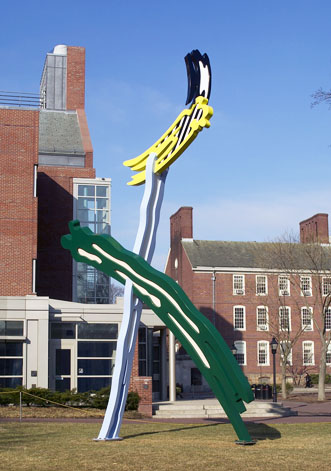
|
October 30, 2007 |
Art on the Move
Lichtenstein Sculpture Brushstrokes to Depart for Florida
Roy Lichtenstein’s 30-foot sculpture, Brushstrokes, will be removed from its site outside MacMillan Hall on Tuesday, Nov. 6, 2007. It has been on display since December 2003, on loan from the estate of the artist. | |||
|
Brown University Home |
PROVIDENCE, R.I. [Brown University] — After nearly four years on display at Brown University, renowned pop artist Roy Lichtenstein’s 30-foot sculpture, Brushstrokes (2006), will be removed from its site outside MacMillan Hall on Tuesday, Nov. 6, 2007. On loan from the estate of the artist, the work has been part of the Art on Campus Program, established by the Public Art Committee of Brown University. 
The 3,400-pound sculpture, composed of painted and fabricated aluminum, will be moved in one piece. It will be lifted by a crane and wrapped in protective casing before being transported to the Fairchild Tropical Botanic Garden, in Coral Gables, Fla., where Brushstrokes will be installed with nine other Lichtenstein sculptures in an exhibition titled Lichtenstein at Fairchild, opening Dec. 8, 2007. “We are sorry to see Brushstrokes leave
Brown,” said Jo-Ann Conklin, director of the Bell Gallery and member of
the Public Art Committee. “It looks quite at home next to MacMillan
Hall and has been a great addition to the campus. Both students and
faculty have expressed their regrets about its departure.” Roy Lichtenstein Roy Lichtenstein (1923-1997) is perhaps best known as a painter and his many paintings based on comic strips epitomize modern American Pop Art. Yet Lichtenstein also created a remarkable and unusual body of sculptural work, including Brushtrokes. Born in Manhattan, Lichtenstein majored in art and earned a Master of Fine Arts degree at Ohio State University. After serving in the U.S. Army during World War II and teaching at Ohio State for several years, he returned to New York in 1960 and soon became famous for his innovative style of painting and for his bold, yet refined and witty adaptations of the shorthand of commercial illustration. In 1965, he returned to his earlier, periodic work with sculpture; much of his three-dimensional work after that extended and played upon his fascination with both commercial and high art. His sculptures, like his paintings, are often colored with Benday dots, the round specks used in commercial photo-engraving to create the illusion of volume on a two-dimensional surface. Public Art at Brown Inaugurated by the Public Art Committee in fall 2002, the Art on Campus Program facilitates long-term loans of significant works for installation in public sites around the Brown campus. The Public Art Committee is a subcommittee of the Committee on Facilities and Design. Members include Chancellor Emeritus Artemis Joukowsky; President Ruth J. Simmons; Robert Emlen, University curator; Richard Fishman, professor of visual art and director of the Creative Arts Council; Dietrich Neumann, professor of the history of art and archaeology; and Jo-Ann Conklin, director of the David Winton Bell Gallery. Other installations arranged by the committee include Tripes (1974) by Alexander Calder, Square Roots (2006) by Patrick Dougherty, Box Cross (2002) by David Nash, Lichtenstein’s Metallic Brushstroke Head (1994), and Isamu Noguchi’s sculpture To Tallness (1981). Untitled (donkey) (2003) by Italian artist Paola Pivi graced the façade of the Science Library from April to August 2004. Editors: Brown University has a fiber link television studio available for domestic and international live and taped interviews, and maintains an ISDN line for radio interviews. For more information, call (401) 863-2476. ###### | |||